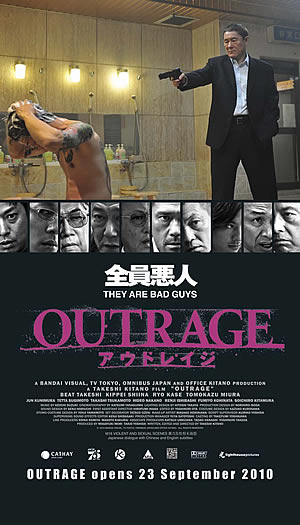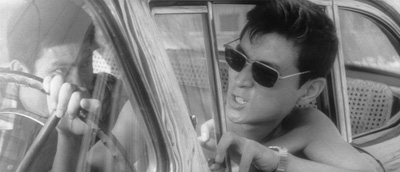A couple of years ago "Beat" Takeshi Kitano returned to the yakuza genre, writing, directing and editing Outrage. I have to admit I was excited; Violent Cop, Boiling Point, Sonatine, Fireworks -- the guy's made some fantastic yakuza pictures. I also have to admit that I was a little disappointed with Outrage.
To its credit, the cinematography and production design are immaculate. Outrage is a gorgeous film to look at. However, the old vibe is gone. Kitano's 90s films had a trademark Zen calm, punctuated with short, sharp shocks of ultra-violence. Here, the former has been dialed way down and the latter way up. Don't get me wrong, I have no problem with ultra-violence, when it's called for. However, the Grand Guignol portions on offer here seem a bit overdone, as if the old outrager had become unsure of his game -- after so many years of being outrageous, he appears to have lost his balance, his deft touch gone all ham-fisted.
The story involves an internecine squabble between two yakuza groups that spirals out of control, causing lost pinkies, dental torture and, ultimately, mass carnage. Poor old Renji Ishibashi (Ronin-gai, Audition, Crest of Betrayal, Dora-heita, tons more) gets the worst of it, having the misfortune to be in the dentist's chair at the wrong moment. Beat Takeshi's character is the loyal lieutenant manipulated by his boss and higher ups into essentially destroying himself (by way of destroying others). You could say he was only following orders, but that's turned out to be not such a good defense …
Don't get me wrong, Outrage is not a bad movie. In fact, compared to most of the crap coming out these days, it's damn good. I'm only comparing it to it's predecessors. Beat Takeshi set such a high bar that his toughest competition is himself. No artist wants to admit it, but they all have an arc; they reach the peak of their creative potential and come back down. Rarely do they get a second one. Outrage is a Beat Takeshi film on the downside of the arc. Far from the bottom of the chart, I should add.
So should you see it? If you're a Takeshi Kitano fan, I'd say definitely. It's good to see the old boy again, slapping people around, shooting them and generally causing mayhem. If you like Japanese film and want to see Tokyo in all its gorgeousness, another reason for a look see. For those more sensitive souls (who probably aren't reading a blog like this), I'd advise a pass. Outrage is a brutal film about brutal men doing brutality. On the other hand, if that's your thing, tuck in!
THROWBACK THURSDAY / NOIR CITY 14 (2016): Humoresque (1946)—Eddie Muller’s
Introduction
-
I first saw *Humoresque (1946)* projected large at the Castro Theatre at
the 14th edition of Noir City (2016) and never got around to transcribing
Eddie ...
13 hours ago










